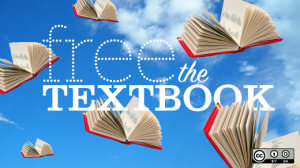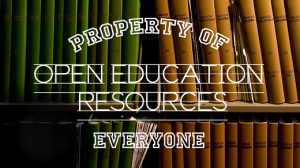This semester, students may have noticed that they spent less money on required textbooks. That’s because Mullen Library, along with its partners in the Washington Research Library Consortium (WRLC) recently joined the Open Textbook Network. This group of colleges and universities has joined together to produce openly-licensed textbooks — written by academics and peer-reviewed, but made available online for free use by all. Nearly 700 textbooks are currently available, with more added all the time (“Introducing the Textbooks on Reserve Pilot Program,” 2020).

The Open Textbook Network is just one example of a trend that is reshaping higher education: Open Educational Resources, or OER. It’s a movement that aims to democratize education by allowing for the unlimited use, reuse, and modification of educational materials, at no cost to students or instructors.
What is OER?
Open Educational Resources refers to freely accessible content, digital or otherwise, that can be used for teaching and learning — lesson plans, textbooks, lecture notes and videos, and even full courses. In order to be considered OER, content must be openly licensed, allowing for a wide variety of uses. While licensing agreements vary, most OER allows for the following, known as the “Five Rs”:
- Retain – users can download, duplicate, and control copies of the content
- Reuse – the material can be used in a wide variety of ways, including in-person classes, via video, or online
- Revise – users can adapt or modify the content to suit their specific teaching and learning needs
- Remix – users can combine the content with other information, either original or from other open sources, to create a completely new resource
- Redistribute – users can disseminate the content, along with any modifications or remixes, as widely as they need to (for example, share it with other instructors)
A Brief HIstory of OER
While the term “open educational resources” was first coined at a 2002 conference of the United Nations Educational, Scientific and Cultural Organization (UNESCO), the idea had been circulating among educators for several years already. The open-source software movement of the late 1990s and the rise of distance-learning options around the same time led academics to consider how combining those ideas could help create a new paradigm of education. One early example of OER is the Massachusetts Institute of Technology’s 2001 decision to put all of its course materials online as part of the OpenCourseware Project. MIT courses can now be accessed by anyone, anywhere, for free (although MIT does not award degrees or credits based on the use of this content) (Guttenplan 2010).
 In 2012, UNESCO and other global partners met in Paris, France, for the First World OER Congress, where they adopted the Paris OER Declaration. The Declaration “reaffirmed the shared commitment of international organizations, governments, and institutions to promoting the open licensing and free sharing of publicly funded content, the development of national policies and strategies on OER, capacity-building, and open research” (Miao et al 2016). In 2017, at the Second World OER Congress in Ljubljana, Slovenia, the partners adopted the Ljubljana OER Action Plan. This list of 41 actions offers ways to help bring open-licensed resources into the mainstream, including enhanced training for librarians and educators on finding and using OER; making resources available in a wide variety of languages, and ensuring equitable and inclusive access (Ljubljana OER Action Plan 2017).
In 2012, UNESCO and other global partners met in Paris, France, for the First World OER Congress, where they adopted the Paris OER Declaration. The Declaration “reaffirmed the shared commitment of international organizations, governments, and institutions to promoting the open licensing and free sharing of publicly funded content, the development of national policies and strategies on OER, capacity-building, and open research” (Miao et al 2016). In 2017, at the Second World OER Congress in Ljubljana, Slovenia, the partners adopted the Ljubljana OER Action Plan. This list of 41 actions offers ways to help bring open-licensed resources into the mainstream, including enhanced training for librarians and educators on finding and using OER; making resources available in a wide variety of languages, and ensuring equitable and inclusive access (Ljubljana OER Action Plan 2017).
Benefits of OER
OER has its challenges–for example, ensuring that content that anyone can edit is accurate (Wikipedia is a great example). However, it also has many benefits for students, instructors, librarians, and researchers:
- Learning anywhere, anytime. Consider the situation in which the Catholic University community–along with many other institutions around the world–finds itself during the COVID-19 pandemic. The use of OER ensures that instructors and students can still access lectures, textbooks, and other essential materials, all without having to set foot in a classroom.
- Easily modified course materials. Not all OER is one-size-fits-all, but open licensing allows instructors to add, subtract, and/or combine components to fit their needs, and those of their students.
- Support for all styles of learning. OER includes a huge variety of material that can be used to create traditional lessons, active learning activities, and more.
- Speed. The publishing cycle for most traditional textbooks can take time, but online, openly-licensed textbooks can be disseminated much more quickly–which also ensures that information is as up to date as possible.
- Cost savings. A study by the College Board found that undergraduate students pay, on average, $1,240 a year for textbooks (“Average estimated undergraduate budgets by sector,” 2020). At Catholic University, the most expensive traditional textbook, an accounting text, costs students $446 (“Introducing the Textbooks on Reserve Pilot Program,” 2020). Open-access textbooks and other readings are a significant savings for students, opening up the world of higher education to a larger percentage of the population.
Start Learning (or Teaching)
There are many ways the Catholic University community can make the most of available OER resources.
- Online courses: In addition to MIT OpenCourseware, you can access full university courses, some (not all) of which are licensed for reuse, at Coursera or EdX.
- Free textbooks: Along with the Open Textbook Network, you can also find a wealth of resources at College Open Textbooks or the Open Textbook Library.
- Repositories: Some large, searchable online repositories, such as Merlot or the OER Commons, offer a huge variety of open teaching and learning resources, books, audio/video, and more.
- LibGuides: Many universities have comprehensive subject guides on open educational resources, with lists of links to even more information. Try these guides from the University of Pittsburgh, Southern Illinois University Edwardsville, and Central Connecticut State University.
- Watch a TED Talk on OER by Dr. David Wiley, one of the pioneers of the OER movement.
To help promote OER and other open access initiatives, liaison librarian Kevin Gunn coordinates CUA’s participation in International Open Access Week each October. First held in 2007, Open Access Week is a worldwide event that helps OER advocates share information and learn from one another about developments in the field. You can read about previous Open Access Week initiatives at CUA in the Mullen Library blog, “What’s Up.”
— Tricia C. Bailey
References
Centre for Educational Research and Innovation (2007). Giving knowledge for free: The emergence of open educational resources. Paris, France: OECD Publishing. Retrieved from http://www.oecd.org/education/ceri/38654317.pdf
College Board (2020). Average estimated undergraduate budgets by sector, 2019-20. Retrieved from https://research.collegeboard.org/trends/college-pricing/
Guttenplan, D. D. (2010). “For Exposure, Universities Put Courses on the Web”. New York Times. New York. Retrieved from https://www.nytimes.com/2010/11/01/world/europe/01iht-educLede01.html?pagewanted=all.
Miao, Fengchun, Mishra, Sanjaya, &McGreal, Rory (2016). Open educational resources: policy, costs, transformation. Paris, UNESCO. pp. 8, 17, 20–21. ISBN 978-92-3-100158-1.
UNESCO (2017). Ljubljana OER action plan. Retrieved from https://en.unesco.org/sites/default/files/ljubljana_oer_action_plan_2017.pdf
Wade, Lea. (2020, January 21). Introducing the textbooks on reserve pilot program [Blog post]. Retrieved from https://www.lib.cua.edu/wordpress/newsevents/12311/.
